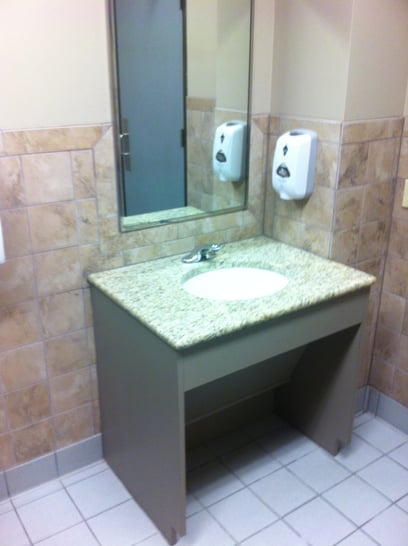
Before and after retirement is an excellent time to prepare the house for what might come next in life—before any significant health issues appear. Choosing to Age in Place earlier in life using Universal Design techniques means a family can longer enjoy the home without obstruction. Their relatives, visitors, and children have peace of mind assured the aging loved ones or the chronically ill are safer living at home.
Everyone planning to remain in their existing home to Age in Place is looking for safety, security, familiarity, ease of use, and comfort. Homeowners and their families should immediately plan for their future housing needs and work from an Aging in Place design checklist. The current housing inventory does not offer the features needed for safety and accessibility in the numbers required to accommodate the growing demand creating a need for home modifications and a niche market. Savvy homeowners and their family have weighed the costs of institutional living compared to their home’s expenses. They also realize the difference in adhering to stringent rules in an institutional facility instead of independently and freely residing in their present home.

The truth is, with professional help, you can adapt almost any home environment to enable you and everyone else in the family to live within it safely to the fullest extent. Aging in place design is not age-related because disability can instantly strike any family member of any age. The need for increased home accessibility is the common thread in any situation. Universal Design or inclusive design is a design and building pathway making homes more accessible to all regardless of their age, mobility, or ability when appropriately used. The Universal Design process offers a seamless path for Aging in Place providing help for those with a sudden disability. It additionally addresses the requirements of special needs families or multigenerational living situations. The elements of Universal Design provide common sense solutions for diverse living conditions.
Regardless of size or ability, people are becoming more familiar with Universal Design and Aging in Place when considering a home remodeling project. Some people use these words interchangeably, but while they are similar in nature, they do differ because of the time they are performed. Both are specific design techniques used in making a home more comfortable and accessible for individuals of different abilities. Universal Design deals more with customized new dwellings and a proactive remodeling approach for people desiring to Age in Place prior to any health issues taking over their life. Comparatively, Aging in Place home modifications strictly involve the remodeling of existing homes to accommodate physical needs brought on by sudden health issues in a reactive manner. The costs for both processes represent a beneficial investment in your home for future needs as opposed to merely spending involving aesthetically pleasing remodeling projects.
As an Aging in Place Specialist and one of Austin's premier Aging in Place contractors, I came to realize existing homes typically contain cramped, twisting hallways with narrow doorways, bathrooms without adequate maneuvering space for decreased usability, kitchens without accessible storage and workspaces, and stepped home entries. These are all common home design flaws. Every one of these common household problematic areas falls short of any Aging in Place design features. Hence, the home building industry has always lacked inclusion for all homeowners with their ever-changing needs.

As a Certified Aging in Place Specialist CAPS(#1636580), I am confident my book, "Age in Place at Home", introduces you to a new way of thinking about your home's future. It acts a guide for solving diverse home needs for all people affected by varying physical conditions and aging. I decided to write this book due to many customer requests for a summation of suggestions to improve their home's accessibility, comfort, usefulness, and sustainability and, ideas they could share with others. The book is full of Aging in Place design guidelines gleaned from witnessing years of shortcomings in traditional homes. I based the information provided on countless past home walkthroughs and home assessments. Within my book, you can discover room-by-room the benefits of using the principles of Universal Design and how to incorporate them periodically throughout your living environment at your own pace. I furthermore guide you through a home, making suggestions for what will increase your and your family's future accessibility. You will notice the chapters involving the bathroom and kitchen are very extensive. They represent the most important rooms to consider when planning to Age in Place. The most utilized rooms in our homes must accommodate all diverse residents and visitors.
Would you please not allow your home to hold you or any of your loved ones captive within its walls. Learn how to enable your home to conform to you and the needs of your family. Please think ahead positively and proactively while preparing for the future. IT JUST MAKES GOOD SENSE.

According to the 2000 census, nearly 50 million people in the United States have some type of disability. Of this group, 6.8 million have a condition that makes it difficult to bathe, dress and get around the inside of their own homes. T-Square Company has the training and knowledge to help with disabilities because we are a Certified Aging in Place Specialist (CAPS).
#accessiblehomes
Tags:
ADA compliant kitchen cabinets,
ADA accessible,
barrier free access,
aging in place remodeling,
ADA remodeling,
aging in place remodels,
ADA kitchen cabinets,
handicap accessible bathrooms,
aging in place construction,
CAPS professional in Austin,
accessible home remodeling,
CAPS remodeling techniques,
disability home remodeling in Austin,
aging in place specialist,
aging in place services,
aging in place design,,
certified aging in place specialist,
handicap remodeling contractors in Austin,
handicap home modifications for disabled,
disability access bathrooms Austin,
universal design ideas,
Austin accessible home remodeling,
certified aging in place consultant in Austin,
aging in place specialist in Austin,
senior aging in place services,
home remodeling for disabled,
home accessibility help in Austin,
home remodeling for disabled in Austin Texas,
wheelchair accessible home remodeling in Austin,
universal design remodeling contractor,
principles of universal design,
disability contractor in Austin,
special needs contractor in Austin,
handicap accessible remodeling,
barrier free remodeling,
handicap accessible home modifications,
disability remodeling,
handicap bathroom remodel,
disability access contractor,
barrier free showers in Austin,
ADA vanity in Austin,
accessible bathroom remodel,
what is ada compliant,
accessible homes,
universal design contractor,
accessible housing,
Austin home remodeling for disabled,
modifying your home for a disabled child,
wheelchair accessible homes,
the basics of aging in place,
barrier free kitchens,
barrier free design,
Austin home accessibility solutions,
Age in Place at Home
Physical limitations affect many more people than the daily users of walkers and wheelchairs. Many members of our society experience a need for elder construction and disability remodeling having significant problems in dealing with their home environment. Today's conventional building standards conflict with most people's accessibility when you consider our created architectural barriers concerning cabinetry and door opening widths, individual strength, range of motion, movement, manual dexterity, balance, and coordination. Once the demands of our built environment exceed their capacities we become excluded from a room or even the entire home. The building world must work in unison to be sure the entire living environment meets basic needs in addition to affordability and structural integrity for the consumer and homeowner. This includes both the home and the components within the home being accessible to all inhabitants. Privacy, sense of belonging, sense of control, and the sense of safety and security make up the quality of life for any home and should be considered for any design.
The concept of successful aging has become increasingly important as senior citizens begin to dominate the population. An active engagement in life through participation in social and productive activities is one component of successful aging. The built environment directly impacts the engagement profiles of older adults so it is necessary to provide environments designed to suit the needs of aging adults. Of all the design theories that attempt to accommodate the aging process, Universal Design may be the most desirable option as it provides built environments that benefit everyone. Universal Design is a promising voluntary philosophy that requires increased attention from designers and builders participating in Aging in Place. Taken as a whole, it is evident that the application of Universal Design into the built environment is a positive step toward successful aging.

The new evolving concept known as Universal Design for home remodeling is catching on nationwide and has been for several years as a sign of the times. Universal Design principles used in building or remodeling make a home more accessible to all regardless of their mobility or adaptive abilities. Furthermore, the evolution of new products used for disability home modifications is making those homes more accessible and has finally come about in the remodeling industry. These new advances in accessible home remodeling in Austin not only keep the living environments safer but will not compromise the home's aesthetics. In fact, there are many benefits to using Universal Design techniques, including potential ease of use by aging family members, added resale value, and the fact that you'll be creating a space that can be used by anyone who visits your home, regardless of their range of abilities. Universal Design offers a clear path for Aging in Place within any home.
Simple Universal Design updates for Aging in Place home modifications and handicap accessibility can include adding grab bars or handrails throughout the home, adding a seat within the roll-in shower, lowering upper cabinets and countertops, adding non-slip flooring, widening hallways or installing stairlifts, and widening doors. You might also consider lowering light switches and thermostats and installing easier-to-use doorknobs. You should try to provide a clear barrier-free path or accessible route to the most visited areas of your home as recommended by the ADA. Remember that more open space gives room for maneuverability while using any mobility aid required.
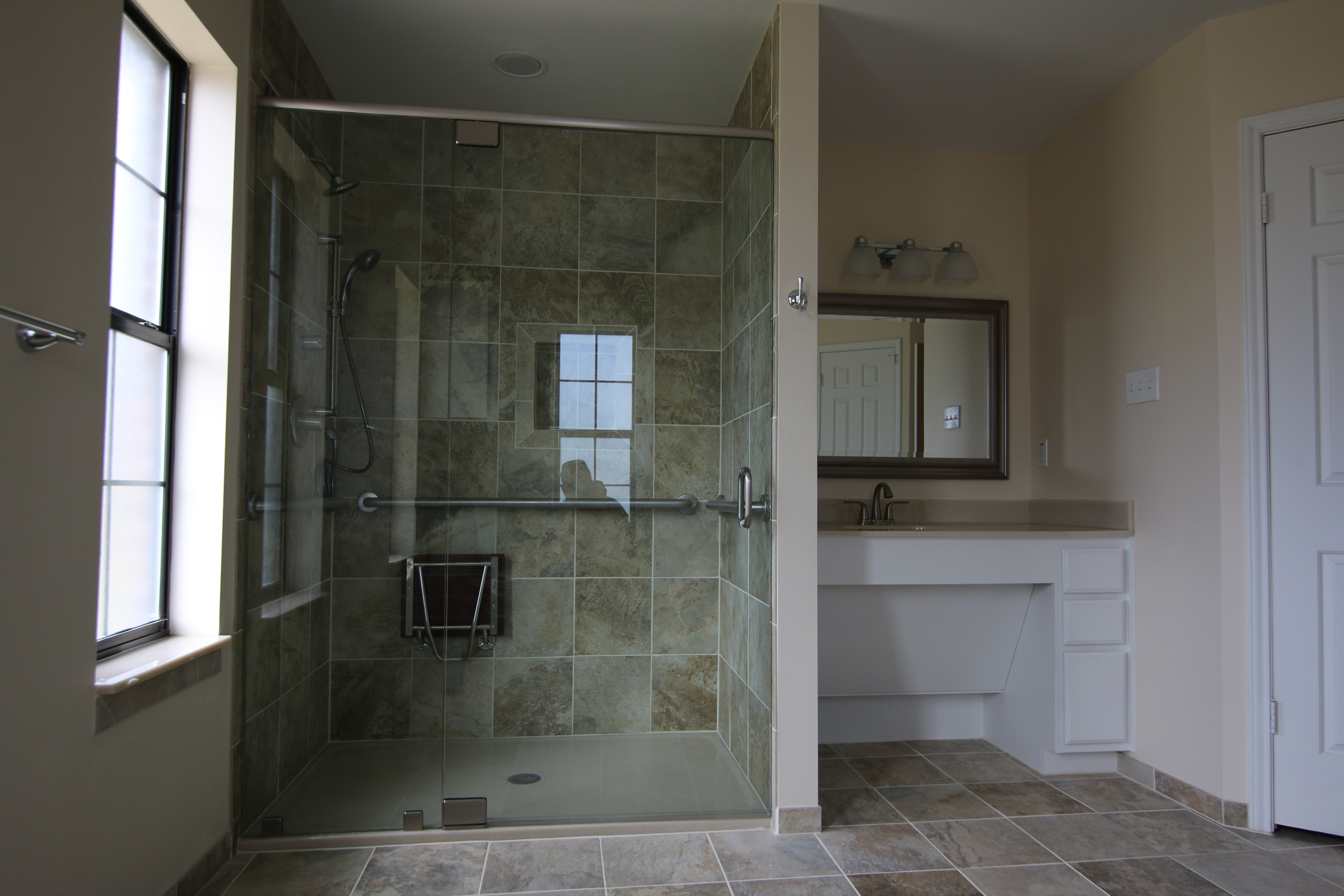
When mobility becomes an issue for any homeowner or family member, regardless of age, the question arises concerning physically moving to a different home on one level with at least a bath that is more accessible. Austin handicap remodeling can help in preparing for one of those highly likely events involving someone in your home needing room modifications for even a short time while recovering from surgery is surely a smart move. Solving Aging in Place issues will soon become the number one challenge concerning the present obsolete housing inventory in our country. Our present-day obsolete homes now inhabited by the baby boomer generation will slowly and increasingly raise their outdated and obsolete ugly heads and expose their true lack of accessibility to those very people inhabiting them. The situation will only become ever more expanding in time. When these homes were previously purchased, they represented an absolute castle in the world of their owners in which to prepare for a day and they also acted as a retreat from life's tough interactions. They housed our families, our memories, and our stuff. They represented a place where we could be ourselves. Our homes have always been exempt from any and all of the accessibility regulations that have been put in place since 1968 when our Viet Nam veterans were returning home.

Let's face it, accessible homes are needed by all of us at some time in our lives even for a short time. This is true whether it's for ourselves, a family member, or a guest. The need is certainly not driven by age but is a result of life's experience sometimes requiring wheelchair remodeling. Any family living with a disability among any of its generations within its group can always benefit from additional home accessibility.
Everyone ages differently and has different needs and wants. The factors that constitute the Aging in Place market for all individuals are based on a person's genetic makeup, their lifestyle including the choices they have made while living their life, and their environment. These factors have brought about the need for universal design principles. This is the design of products, services, and environments that are usable by as many people as possible regardless of age, ability, or situation without the need for adaptation or specialized alterations. It provides for the greatest safety and access for any home guests or occupants and is undetectable when done well. Since so very few homes share the accessibility offered by Universal Design, to satisfy the needs of a particular household member brought about by an accident, an illness, or simply the aging process there will always be a need for customized accessibility features. This will be accomplished by a CAPS accredited remodeling professional producing a truly functional design. This same competent home remodeling company that understands and practices accessible home modifications in Austin should carry out the work to fit the design and ensure your safety and accessibility. The criteria for home accessibility are not common knowledge among builders. It is acquired and practiced knowledge.
The National Association of Home Builders, in partnership with the AARP and Home Innovation Research Labs, created the CAPS program, which includes training and education on the technical, business management, and customer service skills essential to compete in the fastest-growing segment of the residential remodeling industry--home modifications for Aging in Place. David L. Traut, CAPS owner of T-Square Company in Austin, Texas is one of the select group of professionals nationwide to earn the Certified Aging in Place Specialist (CAPS) designation more than a decade ago, identifying him as a home remodeler and builder with the skills and knowledge necessary to remodel or modify a home to meet the unique needs of the older population, disabled owners or their visitors. We generate handicap accessible floor plans for our clients with special needs. Our design/build projects have helped countless homeowners through the VA, HUD, and the private sector. The home modifications we offer will in turn increase safety and independence for all involved as they go through life.
For additional information about the CAPS program, visit nahb.org/CAPS. For more information about T-Square Company, visit www.tsquareco.com or call 512-444-0097.

Tags:
aging in place home modifications,
custom tub to shower conversions,
barrier free remodeling,
disability remodeling,
handicap bathroom remodel,
accessible home remodeling for disabilities,
barrier free showers in Austin,
handicap ADA roll in shower,
wheelchair accessible shower stalls,
roll in shower,
ADA vanity in Austin,
wheelchair accessible toilets,
barrier free toilets,
handicap accessible toilets,
roll under vanity,
home remodeling near me,
home remodeling professional,
accessible bathroom remodel,
specialty construction in Austin,
professional construction services in Austin,
wheelchair ramp specifications,
Austin shower remodel,
bathroom remodel contractors near me,
why universal design,
wheelchair accessible housing,
accessible housing,
handicap accessible house plans,
accessible homes in austin,
handicap bathroom contractor in Austin,
handicap accessible floor plans,
accessible home builder in Austin,
wheelchair accessible homes,
special needs contractor,
universal home design in Austin,
home renovations for disability in Austin,
disability remodeling contractor in Austin,
Professional Disability Remodeling Contractor,
disability home remodeling near me

Everyone planning to remain in their home to Age in Place is looking for safety, security, ease of use, and comfort. Homeowners and families must plan for future housing needs. The current housing inventory does not offer the features needed for safety and accessibility in the numbers required to accommodate the growing demand. They have weighed the costs of institutional living compared to their home’s expenses. They also realize the difference in adhering to stringent rules in a facility instead of independently and freely residing in their present home.
Before and after retirement is an excellent time to prepare the house for what comes next in life—before any significant health issues appear. Choosing to Age in Place earlier in life using Universal Design techniques means a family can longer enjoy the home without obstruction. Their relatives, visitors, and children have peace of mind assured the aging loved ones or the chronically ill are safer living at home.
The truth is, with professional help, you can adapt almost any home environment to enable you and everyone else in the family to live within it to the fullest extent safely. The process is not age-related. Disability can strike any family member at any age. The need for greater home accessibilty is the common thread. Universal Design or inclusive design is a design and building pathway that makes homes more accessible to all regardless of their age, mobility, or ability when appropriately used. The design process offers a seamless path for Aging in Place. It addresses the requirements of special needs families or multigenerational situations. Solutions for diverse living conditions are now becoming a possibility.
Regardless of size or ability, people are becoming more familiar with Universal Design and Aging in Place if considering a home remodeling project. Some people use these words interchangeably, but while they are similar, they do differ. Both are specific design techniques used in making a home more comfortable and accessible for individuals of different abilities. Universal Design deals more with customized new dwellings and a proactive remodeling approach for people wanting to Age in Place before any health issues arise. Aging in Place strictly involves remodeling existing homes to accommodate physical needs brought on by sudden health issues in a reactive manner. The costs for both processes represent a beneficial investment in your home for future needs as opposed to merely spending involving aesthetically pleasing remodeling projects.
I came to realize over my building career that including cramped twisting hallways with narrow doorways, bathrooms lacking maneuvering space and usability, kitchens without accessible storage and workspaces, and stepped home entries were repeating home design flaws. The home building industry has always lacked inclusion for all homeowners with their ever-changing needs.

As a Certified Aging in Place (CAPS) professional (#1636580), I am confident this book, which will hopefully be available toward the end of 2022, will introduce you to a new way of thinking about your home's future. It offers a guide for solving diverse home needs for all people affected by varying physical conditions and aging. I decided to write this book due to many customer requests for a summation of suggestions to improve their home's accessibility, comfort, usefulness, and sustainability and, ideas they could share with others. I based the information provided on countless past walkthroughs and home assessments. Inside, you can discover room by room the benefits of using the principles of Universal Design and how to incorporate them periodically throughout your living environment at your own pace. I guide you through a home, making suggestions for what will increase your and your family's future accessibility. You will notice the chapters involving the bathroom and kitchen are pretty extensive. They represent the most important rooms to consider when planning to Age in Place. The most utilized rooms in our homes must accommodate all diverse residents and visitors.
Would you please not allow your home to hold you or your loved ones captive within its walls and enable your home to conform to you and the needs of your family. Please think ahead positively and proactively while preparing for the future. IT JUST MAKES GOOD SENSE.

#accessiblehomes
Tags:
ADA compliant kitchen cabinets,
ADA accessible,
barrier free access,
aging in place remodeling,
ADA remodeling,
aging in place remodels,
ADA kitchen cabinets,
handicap accessible bathrooms,
aging in place construction,
CAPS professional in Austin,
accessible home remodeling,
CAPS remodeling techniques,
disability home remodeling in Austin,
aging in place specialist,
aging in place services,
aging in place design,,
certified aging in place specialist,
handicap remodeling contractors in Austin,
handicap home modifications for disabled,
disability access bathrooms Austin,
universal design ideas,
Austin accessible home remodeling,
certified aging in place consultant in Austin,
aging in place specialist in Austin,
senior aging in place services,
home remodeling for disabled,
home accessibility help in Austin,
home remodeling for disabled in Austin Texas,
wheelchair accessible home remodeling in Austin,
universal design remodeling contractor,
principles of universal design,
disability contractor in Austin,
special needs contractor in Austin,
handicap accessible remodeling,
barrier free remodeling,
handicap accessible home modifications,
disability remodeling,
handicap bathroom remodel,
disability access contractor,
barrier free showers in Austin,
ADA vanity in Austin,
accessible bathroom remodel,
what is ada compliant,
accessible homes,
universal design contractor,
accessible housing,
Austin home remodeling for disabled,
modifying your home for a disabled child,
wheelchair accessible homes,
the basics of aging in place,
barrier free kitchens,
barrier free design,
Austin home accessibility solutions,
Age in Place at Home
As a universal design/build construction company located in Austin, Texas, T-Square Company realizes that building for your future changing needs is a very valuable consideration concerning all your periodic remodeling projects. We always design for the future for our clients, regardless of their age or abilities. This thought process is especially true when designing a bathroom upgrade. Being a nationally CAPS certified remodeler, we are very aware your personal needs can change in the blink of an eye. The daily tasks of getting into the bathroom, bathing, showering, using the toilet, or brushing your teeth can become almost impossible without assistance if you don't address your bathroom's inaccessibility in a proactive manner. Any revisions must be completed before you absolutely need the help. Design shortcomings become ever so noticeable if you have an accident and are recovering at home or a debilitating disease sets in. Most all problems caused by architectural barriers will be eliminated with a handicap accessible bathroom remodel.
We are certain that avoiding emergency remodeling while incorporating Universal Design techniques into your home whenever possible is a great way of enhancing your health, independence, and safety. This practice also provides a better overall quality of life. The sooner the main inaccessible areas in your home are addressed, the longer you and your family have to enjoy them. For those desiring to Age in Place, as in safely living in your own home for as long as possible, gradually incorporating the principles of Universal Design into all remodeling projects provides a seamless gateway for successful aging. So, what are the main concerns when designing a bathroom for the future?
Getting Into The Bathroom
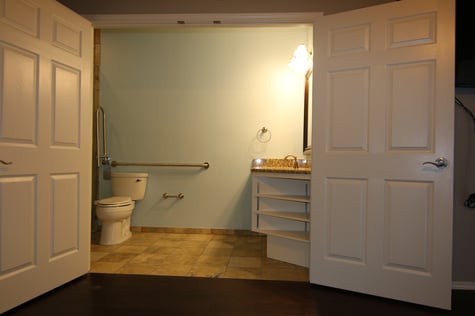
When possible, you should always install a 36-inch wide door into your bathroom allowing all mobility devices to enter without obstruction. Sometimes it's easier when walls cannot be altered or removed to make a large double door entry into the bathroom. Replacing the original twenty-four to twenty-eight-inch wide door offers maximum accessibility for anyone. This universal design element provides clear approaches toward all bathroom fixtures from an adjoining room. Additionally, an unobstructed 60-inch wheelchair turning radius is shared by the bathroom and adjacent room.
An Accessible Shower
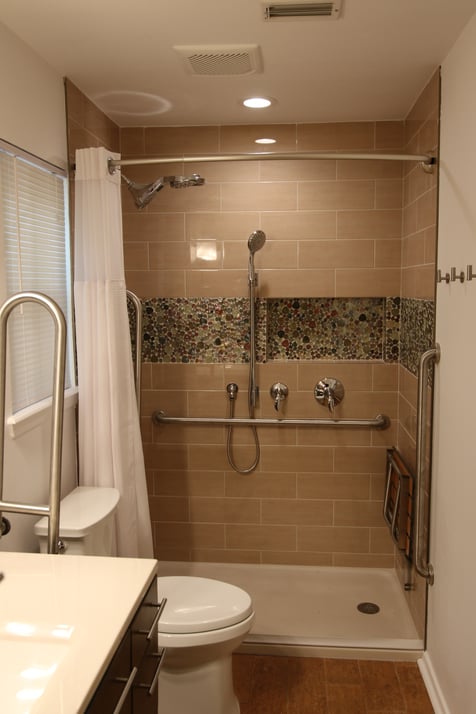
A safe, low-profile (1 1/2" tall) accessible shower with roll-in capability from an add-on ramp suits the needs of most diverse homeowners. Even if you don't require the grab bars during a particular phase of your life, installing adequate blocking before the tile is installed provides a universal path for your future needs once the bars are required. Take note, the grab bars must be able to withstand a shear force of 300 pounds. Their purpose is to provide support and stability when you need it most. Clutter within the shower and especially on the shower floor is a safety hazard. Recessed shampoo niches keep shampoo bottles and other items off the floor. Additionally, folding shower seats are far safer than free-standing models that are rarely ever in the right place. They save space when folded while not in use and never interrupt the use of a shower chair. It is a common misconception that shower controls must be mounted on one wall underneath the fixed shower head. Shower valves can be installed anywhere they are most convenient for the user, especially if a caretaker is involved. A recessed shower can light above the shower decreases shadows and further increases safety.
Using The Toilet
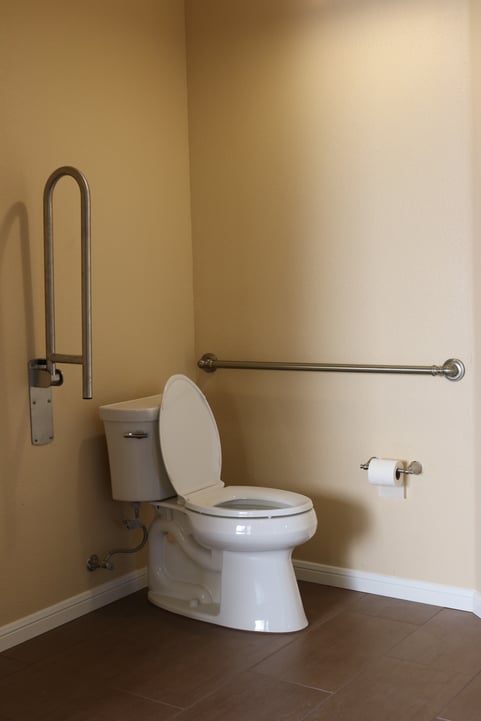
When a toilet exists in a confining room or space, there is no easy way of approaching it if you have mobility problems and especially if you are using any kind of mobility device. After all, safety is the predominant concern when using the toilet. Remove all restricting walls and narrow doors so everyone can freely approach and use the toilet. Once again, grab bars increase safety when they are required and must be adequately prepared for installation. Another problem with toilets involves those that are too short requiring deep knee bends for using them. A higher comfort height toilet offers significant help with this problem. Be sure the flush handle is toward the open side of the bathroom.
Brushing Your Teeth
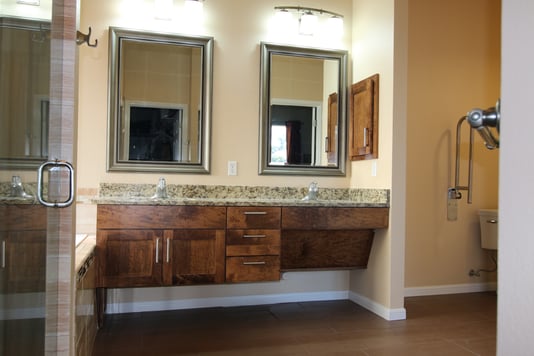
Offering adaptability in a vanity is a universal design aspect. Everyone has equal access while standing or using a wheelchair--if only for a short time during recoveries. More adaptability is offered using multiple height countertops. Lever faucets are easier for everyone to operate, even for those users with arthritis. Motion-sensor faucets create washing areas that are completely hand-free.
When you are ready to take the next steps toward your accessible future, contact T-Square Company in Austin, Texas. We can show you how to address your personal needs using our more than thirty years of knowledge and design/build accessibility experience. We guarantee to keep you safer in your existing home longer and out of dangerous and uncaring institutions using our proven design methods. We offer all handicap accessible home renovations or additions--especially accessible bathrooms.
David L. Traut, CAPS #1636580
Tags:
aging in place remodeling,
custom walk in showers,
certified aging in place specialist,
ADA bathroom Austin, Texas,
disability access bathrooms Austin,
Austin Handicap Remodeling,
universal design ideas,
universal design building for a lifetime,
home accessibility help in Austin,
universal design remodeling contractor,
7 principles of universal design,
applying principles of universal design in Austin,
handicap accessible remodeling,
barrier free remodeling,
disability remodeling,
handicap bathroom remodel,
ADA compliant wheelchair accessible showers,
disability access contractor,
veterans home accessibility help in Austin, Texas,
barrier free showers in Austin,
accessible bathroom design specifications,
ADA vanity in Austin,
accessible toilets,
what is an ADA compliant bathroom,
universal design/build contractor,
universal design vs. aging in place,
home accessibility,
accessible design,
why universal design,
what is aging in place,
accessibility home modifications,
handicap bathroom vanity,
handicap accessible floor plans,
maneuvering in and around the accessible home,
future home building using universal design,
universal design home additions
Traditionally bathroom vanities were constructed so the finished cabinet top was 30” AFF (above finished floor). This meant that taller people had to bend over and stand away from the sink in order to use it. This puts added stress on the lower back and legs diminishing the comfort factor. Typically bathroom vanities are 21" deep and approximately 29" tall. The depth is not a problem but most folks would prefer a universal design height of 34". Universally, sinks shouldn't be mounted higher than 34 inches from the floor to the top of the cabinet top for an under mount or drop in model. The sinks should not exceed six inches in depth and should be installed within three inches from the front of the overhanging cabinet top edge. The ADA vanity cabinet or even a simple wall hung sink should have a knee clearance below of 27 inches high and be at a minimum 32 inches wide by 11-25 inches deep. The choice of sink styles depends on the personal preference of the user. Be sure the lavatory controls are easily controlled with lever or paddle handles and are capable of being operated with one hand and not requiring tight grasping, pinching, or pinching of the wrist. Knobs, discs, or ball type handles can be hard to operate by anyone with soapy hands and more so by someone having an arthritic condition or other ailments. The closer the sink valves can be located toward the front of the sink the better. This can be accomplished by following the curved outline of the sink.
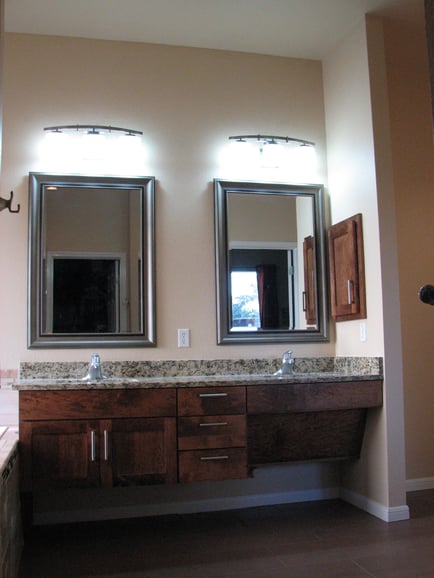
There are basically two styles of ADA vanities that comply with an unobstructed roll under area below the sink. This capability has everything to do with both the water supply lines and the main waste line connecting the sink. There must be provisions made to protect the user from being scalded when coming into contact with any one of the plumbing pipes serving the sink. These connecting pipes may become heated merely by the water passing through them creating a problem of scalding the user especially if they are unable of feeling sensations. The open type model should always receive both waste and supply insulating jackets applied directly to the pipes providing protection for the wheelchair user. The closed model concealing the pipes will be equipped with a removable face or panel board covering the pipes. This pipe concealing panel must be installed at the correct angle. This allows for the needed unobstructed legroom required for the user. The vanity can extend beyond the sink but the area containing the sink is required to have this roll under capability which is 27" tall and 32" wide. This section of the vanity top must not be any taller than 34 inches above the finished floor with the sufficient lower clearance mentioned above. Clear unobstructed reach distances around the counter top area must be observed at 24 inches. Any motion controlled sensors integrated into the various dispensing devices and/or plumbing fixtures throughout the bathroom present a true hands free benefit to all the bathroom users. If these aren't in the budget then at least wrist handles used for controlling the faucet can be incorporated into the design of the vanity. Bathroom vanities with 34" universal height cabinet tops and open knee spaces are taking over the marketplace. These new residential vanities do not need to look institutional. They can be designed like any other piece of fine furniture.
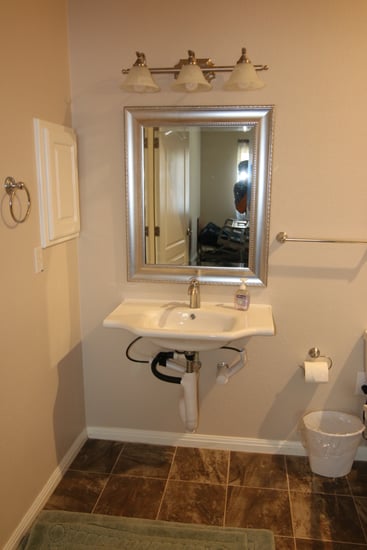
Recommended Clear Dimensions And Requirements
Sinks shouldn't be mounted higher than 34 inches from the floor to the top of the cabinet top for an under mount or drop in model. The sinks should not exceed six inches in depth and should be installed within three inches from the front of the overhanging cabinet top edge. A rear drain is recommended to have the proper clearance when rolling under the vanity. The ADA vanity cabinet or even a simple wall hung sink should have a knee clearance below of 27 inches high and be at a minimum 30 inches wide by 11-25 inches deep. A 9" high clear kick area (by 6" deep) at the floor should be maintained for a full height cabinet and be approximately ten inches deep according to the cabinet depth. Remember twenty four inches is the maximum reach distance while sitting in a wheelchair. Be sure the lavatory controls fall within this range and are easily controlled being operated with one hand and not requiring tight grasping, pinching, or pinching of the wrist.
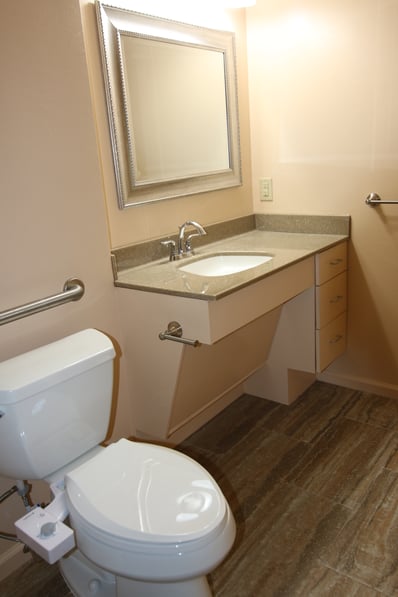
Clear Floor Space
To assure a clear floor space the lavatory must be installed at 24" from any side wall measuring from the center of the sink. The distance from one sink to another if using a double lavatory layout should be at least 30" center to center. In the case of wall hung freestanding sinks the minimum distance between them should be 4" between the sink edges.
A clear floor space of 30 by 48 inches must be provided to access all bathroom fixtures and these areas can overlap one another. The adjoining and overlapping wheelchair turning space should be an unobstructed sixty inches in diameter. A wheelchair turning space could utilize a T-shaped space considering a sixty inch square having two 12"x 24" areas removed from each corner of the square from the same side. This will be a 36" wide base with two 36" wide arms. T-shaped wheelchair turning spaces can include on one arm. In this case the clear width at the cabinet should be 36" to use the space as part of the T-turn.

Let's face it, accessible homes are needed by all of us at some time in our lives. This is true whether it's for ourselves, a family member, or a guest. The need is certainly not driven by age but is a result of life's experience. Any family living with disability among any of the generations within it's group can always benefit from additional accessibility. This will in turn increase safety and independence for all involved as they go through life.
Aging in place home modifications are available through T-Square Company. We are a certified aging in place (CAPS) specialist. Each design/build situation will be customized to fit your personal needs. Call 512-444-0097 today to begin the accessible second chapter of your life while remaining safe and secure in your existing home. CAPS #1636580

Tags:
disability remodeling,
handicap access bathroom remodel,
disability access contractor,
accessible home remodeling for disabilities,
ADA vanity in Austin,
roll under vanity,
what is an ADA compliant bathroom,
universal design/build contractor,
Austin home remodeling for disabled,
accessible home modifications,
wheelchair accessible bathroom,
handicap bathroom design,
handicap bathroom requirements,
handicap bathroom sink,
handicap bathroom vanity,
wheelchair access,
handicap bathroom contractor in Austin,
accessible home builder in Austin,
wheelchair accessible homes,
special needs contractor,
home renovations for disability in Austin,
disability remodeling contractor in Austin,
what is the height of a handicap vanity?,
disability renovation services in a,
disability renovation services in Austin Texas,
ADA Compliant Bathroom Vanity
ADA guidelines state that accessible sinks shouldn't be mounted higher than 34 inches above the floor for adults. For children, the sink should be set at 29 inches maximum above the finished floor. Both these heights are dependent on the individual using the sink and are truly a set of guidelines. Adults should have a knee clearance of 27 inches high by 30 inches of width with 11-25 inches deep. For children or smaller adults, a knee clearance of 24 inches above the floor is recommended. All sinks for the handicapped user should have no more than a 6 1/2 inch depth.There should also be a clear associated floor space for approach in front of the vanity which measures 30 by 48 inches. This clear space is needed to approach all bathroom fixtures and the clear spaces can overlap within the bathroom design. To assure a clear floor space the lavatory must be installed at 24" from any side wall measuring from the center line of the sink. The distance from one sink to another if using a double lavatory layout should be at least 30" center to center. In the case of wall hung freestanding sinks the minimum distance between them should be 4" between the sink edges. A clear 24 inch reach distance must be observed to help assist a seated person.
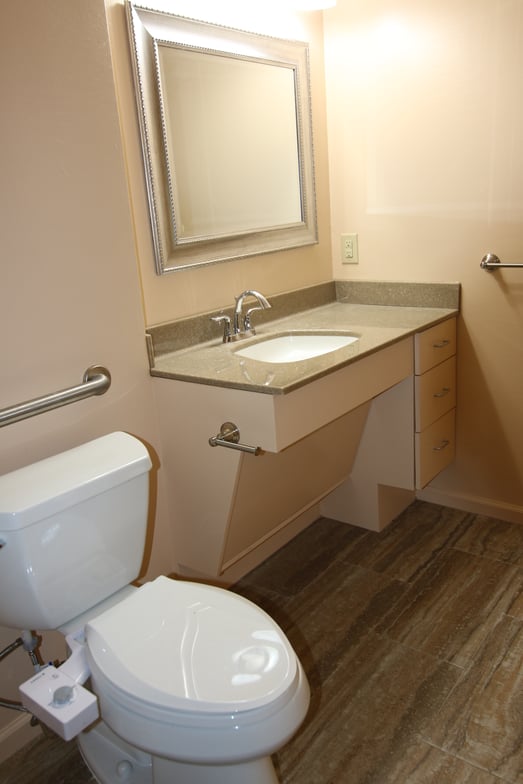
There is no one set of dimensions which works for everyone with special needs since everyone is different. Bathroom cabinets in Austin vary by style and usability needs. There are basically two styles of ADA bathroom vanities that comply with an unobstructed 27" tall roll under area below the sink. ADA sinks with a rear drain location provide for better plumbing drain hook ups. This modification has everything to do with both the water supply lines and the waste line connecting the sink. There must be provisions made to protect the user from being scalded when coming into contact with any one of the plumbing pipes serving the sink. These connecting pipes may become heated merely by the water passing through them creating the problem. The open type model should always receive both waste and supply insulating jackets applied directly to the pipes providing protection for the wheelchair user. The closed model concealing the pipes will be equipped with a removable face or face board covering the pipes. This pipe concealing panel must be installed at the correct wheelchair user clearance angle. This allows for the needed unobstructed legroom required for the user. The vanity can extend beyond the sink but the area containing the sink is required to have this roll under capability. This section of the vanity top must not be any taller than 34 inches above the finished floor with sufficient lower leg clearance. Clear unobstructed reach distances around the counter top area must be observed. Any motion controlled sensors integrated into the various dispensing devices and/or plumbing fixtures throughout the restroom present a true hands free benefit to all the restroom users. If these aren't in the budget then at least wrist handles used for controlling the faucet can be incorporated into the design of the vanity. Furthermore, automatic flush valves should be used on all toilets and urinals that provide for hands free use.

Finding a disability contractor familiar with the guidelines of Elder construction and accessibility for people with special needs can be quite difficult. Be sure to check out the credentials of any potential bidders you contact. Also be sure they understand that the alterations you are seeking are for wheelchair accessible home remodeling and modifications. Furthermore be sure this person knows and practices both the federal and most importantly your state's requirements before entering into any contract. We offer complete handicap accessible floor plans generated around our individual clients.
Aging in place home modifications are available through T-Square Company. We are a certified aging in place (CAPS) specialist. Each design/build situation will be customized to fit your personal needs. Call 512-444-0097 today to begin the accessible second chapter of your life while remaining safe and secure in your existing home. CAPS #1636580
Let's face it, accessible homes are needed by all of us at some time in our lives. This is true whether it's for ourselves, a family member, or a guest. The need is certainly not driven by age but is a result of life's experience. Any family living with disability among any of the generations within it's group can always benefit from additional accessibility. This will in turn increase safety and independence for all involved as they go through life.

Tags:
remodeling for elders in Austin,
disability and special needs contractor Austin,
Austin disability contractors for special needs,
handicap remodeling,
disability remodeling,
handicap access bathroom remodel,
handicap bathroom remodel,
disability access contractor,
veterans home remodeling in Austin, Texas,
ADA vanity in Austin,
ADA vanity height,
roll under vanity,
specialty construction in Austin,
home access in Austin,
bathroom remodel contractor,
home accessibility,
accessible design,
wheelchair accessible housing,
accessible housing,
handicap accessible housing,
handicap accessible house plans,
accessible homes in austin,
Austin home remodeling for disabled,
accessibility home modifications,
accessible home modifications,
wheelchair accessible bathroom,
handicap bathroom design,
handicap bathroom requirements,
handicap bathroom sink,
handicap bathroom vanity,
modifying your home for a disabled child,
handicap bathroom contractor in Austin,
accessible home builder in Austin,
wheelchair accessible homes,
special needs contractor,
home renovations for disability in Austin,
disability remodeling contractor in Austin,
what is the height of a handicap vanity?
The concept of successful aging has become increasingly important as senior citizens begin to dominate the population. An active engagement in life through participation in social and productive activities is one component of successful aging. The built environment directly impacts the engagement profiles of older adults so it is necessary to provide environments designed to suit the needs of aging adults. Of all the design theories that attempt to accommodate the aging process, universal design may be the most desirable option as it provides built environments that benefit everyone. Universal design is a promising voluntary philosophy that requires increased attention from designers and builders participating in aging in place. Taken as a whole, it is evident that the application of universal design to the built environment is a positive step toward successful aging.

Physical limitations affect many more people than the daily users of walkers and wheelchairs. Many members of our society experience a need for elder construction having significant problems in dealing with their home environment. Today's conventional building standards conflict with most people's accessibility when you consider our created architectural barriers concerning cabinetry and door opening widths, individual strength, range of motion, movement, manual dexterity, balance, and coordination. Once the demands of our built environment exceed their capacities we become excluded from a room or even the entire home. The building world must work in unison to be sure the entire living environment meets basic needs in addition to affordability and structural integrity for the consumer and home owner. This includes both the home and the components within the home being accessible to all inhabitants. Privacy, sense of belonging, sense of control, and the sense of safety and security make up the quality of life for any home and should be considered for any design.
When mobility becomes an issue for any homeowner or family member, regardless of age, the question arises concerning physically moving to a different home on one level with at least a bath that is more accessible. Austin handicap remodeling can help in preparing for one of those highly likely events involving someone in your home needing room modifications for even a short time while recovering from surgery is surely a smart move. Solving aging in place issues will soon become the number one challenge concerning the present obsolete housing inventory in our country. Our present day obsolete homes now inhabited by the baby boomer generation will slowly and increasingly raise their outdated and obsolete ugly heads and expose their true lack of accessibility to those very people inhabiting them. The situation will only become ever more expanding in time. When these homes were previously purchased, they represented an absolute castle in the world of their owners in which to prepare for a day and they also acted as a retreat from life's tough interactions. They housed our families, our memories, and our stuff. They represented a place where we could be ourselves. Our homes have always been exempt from any and all of the accessibility regulations that have been put in place since 1968 when our Viet Nam veterans were returning home.
The new evolving concept known as Universal Design for home remodeling is catching on nation wide and has been for several years as a sign of the times. Universal design techniques used in building makes a home more accessible to all regardless of their mobility or adaptive abilities. An evolution of new products used for disability home modifications is making those homes more accessible and has finally come about in the remodeling industry. These new advances in accessible home remodeling in Austin not only keep the living environments safer but will not compromise the home's aesthetics. In fact, there are many benefits to using universal design techniques, including potential use by aging family members, added resale value, and the fact that you'll be creating a space that can be used by anyone who visits your home, regardless of their range of abilities. Simple universal design updates for aging in place home modifications and handicap accessibility can include adding grab bars or handrails throughout the home, adding a seat within the roll in shower, lowering upper cabinets and counter tops, adding non-slip flooring, widening hallways or installing stair lifts, and widening doors. You might also consider lowering light switches and thermostats and installing easier to use door knobs. You should try to provide a clear barrier free path or accessible route to the most visited areas of your home as recommended by the ADA. Remember that a more open space gives room for maneuverability while using any mobility aid required.

Let's face it, accessible homes are needed by all of us at some time in our lives. This is true whether it's for ourselves, a family member, or a guest. The need is certainly not driven by age but is a result of life's experience sometimes requiring wheelchair remodeling. Any family living with disability among any of it's generations within it's group can always benefit from additional home accessibility. We generate handicap accessible floor plans for our clients with special needs. This will in turn increase safety and independence for all involved as they go through life.
Everyone ages differently and has different needs and wants. The factors that constitute the aging in place market for all individuals are based on a persons genetic makeup, their lifestyle including the choices they have made while living their life, and their environment. These factors have brought about the need for universal design. This is the design of products, services, and environments that are usable by as many people as possible regardless of age, ability, or situation without the need for adaptation or specialized alterations. It provides for the greatest safety and access for any home guests or occupants and is undetectable when done well. Since so very few homes share the accessibility offered by universal design, to satisfy the needs of a particular household member brought about by an accident, an illness, or simply the aging process there will always be a need for customized accessibility features. This will be accomplished by a CAPS accredited remodeling professional producing a truly functional design. This same competent home remodeling company who understands and practices accessible home modifications in Austin should carry out the work to fit the design and insure your safety and accessibility.
The National Association of Home Builders, in partnership with the AARP and Home Innovation Research Labs, created the CAPS program, which includes training and education on the technical, business management and customer service skills essential to compete in the fastest growing segment of the residential remodeling industry--home modifications for aging in place. David L. Traut, CAPS owner of T-Square Company in Austin, Texas is one of the select group of professionals nationwide to earn the Certified Aging-In-Place Specialist (CAPS) designation, identifying him as a home remodeler and builder with the skills and knowledge necessary to remodel or modify a home to meet the unique needs of the older population, disabled owners or their visitors.
For additional information about the CAPS program, visit nahb.org/CAPS. For more information about T-Square Company, visit www.tsquareco.com or call 512-444-0097.

Tags:
barrier free remodeling,
disability remodeling,
handicap bathroom remodel,
accessible home remodeling for disabilities,
barrier free showers in Austin,
handicap ADA roll in shower,
wheelchair accessible shower stalls,
roll in shower,
ADA vanity in Austin,
wheelchair accessible toilets,
barrier free toilets,
handicap accessible toilets,
roll under vanity,
home remodeling near me,
home remodeling professional,
accessible bathroom remodel,
specialty construction in Austin,
professional construction services in Austin,
wheelchair ramp specifications,
Austin shower remodel,
bathroom remodel contractors near me,
why universal design,
wheelchair accessible housing,
accessible housing,
handicap accessible house plans,
accessible homes in austin,
handicap bathroom contractor in Austin,
handicap accessible floor plans,
accessible home builder in Austin,
wheelchair accessible homes,
special needs contractor,
universal home design in Austin,
home renovations for disability in Austin,
disability remodeling contractor in Austin
When mobility becomes an issue for any homeowner, regardless of age, the question arises concerning physically moving to a different home with a bath that is more accessible. Preparing for one of those highly likely events involving someone in your home needing room modifications for even a short time while recovering from surgery is surely a smart move. Solving aging in place issues will soon become the number one challenge concerning the present obsolete housing inventory in our country. Our present day obsolete homes now inhabited by the baby boomer generation will slowly and increasingly raise their outdated and obsolete ugly heads and expose their true lack of kitchen or bathroom accessibility to those very people inhabiting them. The situation will only become ever more expanding in time. When these homes were previously purchased, they represented an absolute castle in the world of their owners in which to prepare for a day and they also acted as a retreat from life's tough interactions. They housed our families, our memories, and our stuff. They represented a place where we could be ourselves. Our homes have always been exempt from any and all of the accessibility regulations that have been put in place since 1968 when our Viet Nam veterans were returning home. The new evolving concept known as Universal Design and specialized handicap remodeling contractors for home remodeling is catching on nation wide and has been for several years as a sign of the times. Universal design techniques used in building makes a home more accessible to all regardless of their mobility or adaptive abilities. An evolution of new products used for disability home modifications is making those homes more accessible and has finally come about in the remodeling industry. These new advances in accessible home remodeling in Austin not only keep the living environments safer but will not compromise the home's aesthetics. In fact, there are many benefits to using universal design techniques, including potential use by aging family members, added resale value, and the fact that you'll be creating a space that can be used by anyone who visits your home, regardless of their range of abilities. Simple universal design updates for aging in place home modifications and handicap bathroom accessibility can include adding grab bars or handrails throughout the home, adding a seat within the roll in shower, lowering upper cabinets and counter tops, adding non-slip flooring, widening hallways or installing stair lifts, and widening doors. You might also consider lowering light switches and thermostats and installing easier to use door knobs. You should try to provide a clear barrier free path or accessible route to the most visited areas of your home as recommended by the ADA.
Finding the right contractor with ADA knowledge and experience can be as much of a challenge as maintaining your independence throughout an accessible design in Austin. You should be looking for a contractor who understands life changes. A contractor who offers specialty products and services standing out from the rest of the pack. A contractor who has the ability, through experience, to help clear the murky water impeding your accessible route and how it can be accomplished. One who takes ADA remodeling to another level promoting safety. A well versed construction professional can take on and solve any residential ADA challenge creating an accessible design. These can include widening doorways, ADA compliant kitchen cabinets, or ADA compatible baths.

When increasing home accessibility, door widening is a common problem especially where wheelchair access is a must. All doors should be 36" wide with the correct locking hardware installed. The rule is 32" clear within the accessible route but 32" doors don't give enough clearance because of their stops. You also need to pay attention to which side the lockset is installed on to not limit any wheelchair access or operation of the door's locking hardware.
ADA compliant kitchen cabinets give you the ability to freely roll under the correct depth sink with covered or insulated water and drain lines. The sink should be equipped with a proper automatic or wrist handle faucet. A finished cabinet top height of 34" will also be observed. Wall cabinets should be mounted around 4" lower than usual for reachability from a sitting position. An unobstructed five feet turning radius on the floor should also be maintained.

Bathroom transformations complying with ADA revisions also require the same turning radius noted in the kitchen along with a correct bathing facility. If a tub is useful, correctly placed grab bars must be installed for safety reasons. Showers can be either the roll in or transfer type dictated by the individual user's physical abilities. The comfort height toilet should have grab bars installed at 34" on the side wall as well as at the rear at a minimum. The flush handle should be oriented toward the middle of the room away from the side wall. The bathroom sink should be accessible as in the kitchen mentioned above.
Home Accessibility In Austin
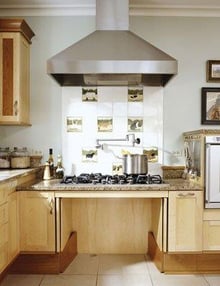
Traditional home builders and remodelers don't really consider the needs of the disabled or elderly like ADA vanities or roll in showers which are universal in nature. It takes a special breed of contractor to realize special needs for special people.
A revolution in building design standards is long overdue. Our current building design standards do not address the needs of more than one third of our existing population. Many more people can greatly benefit from accessible design versus conventional design. Our rapidly aging population is experiencing the limitations of our personal living environments. Any evolution in building practically always begins in the common areas of the commercial building sector. The American Disabilities Act of 1990 increased the attention needed for those people having the right to equally access their work place and any recreational or leisure facilities. These rules at least offer minimal solutions for those needing the most help with any building access. In Austin, we now must provide access to one bathroom on the first floor in new homes as deemed by our newly adopted building regulations. This basic right to a handicap accessible bathroom is finally being enforced by the city's building inspectors. What a tremendous needed and basic design improvement!

Aging in place construction and Austin ADA remodeling has become synonymous with handicap accessible home design and modification during our lifetime. Home modifications can be used to accommodate anyone from people with mobility impairments to those with vision loss, hearing loss, or even cognitive or developmental disabilities. Accessibility home modifications or wheelchair accessible kitchen and bathroom remodeling in Austin will allow anyone with limited mobility within your home to feel more empowered and independent. The extent of a customized accessibility design is dependent upon the activity level of the person requiring the modifications.
Aging in place home modifications are available through T-Square Company in the Austin area. We have an A plus rating with the local BBB and have over 30 years of remodeling experience. We are additionally a certified aging in place specialist offering complete aging in place services. Each design/build situation will be customized to fit your personal needs increasing your accessibility. Call 512-444-0097 today to begin the accessible second chapter of your life while remaining safe and secure in your existing home. CAPS #1636580
Tags:
Texas,
kitchen remodeling,
how-to,
ADA compliant kitchen cabinets,
ADA accessible,
accessible routes,
ADA bathroom cabinets accessible routes,
wheelchair accessible remodeling,
wheelchair accessible baths and kitchens,
ADA remodeling,
ADA bathroom cabinets,
accessibility home remodeling in Austin,
accessible home remodeling,
Austin bathroom remodel,
home modifications for independent living,
handicap remodeling contractors in Austin,
remodel bathroom for handicap Austin Texas,
handicap home modifications for disabled,
handicap remodeling contractors,
home modifications Austin, Texas,
ADA remodeling Austin, Texas,
ADA bathroom Austin, Texas,
handicap accessible remodeling,
barrier free remodeling,
handicap remodeling,
handicap accessible bathroom remodel,
handicap ADA roll in shower,
wheelchair accessible shower stalls,
roll in shower,
accessible bathroom design specifications,
ADA vanity in Austin,
professional remodeling contractor,
home remodeling near me,
professional remodeler,
home remodeling contractor residential,
universal design/build contractor,
home accessibility,
accessible design,
wheelchair accessible housing,
accessible housing,
handicap accessible housing,
handicap accessible house plans
Modifying your bathroom following practiced wheelchair accessibility guidelines is a great place to start any universal remodel. This will provide access for both wheelchairs and walkers. Furthermore, you can help avoid many future injuries. Any wet area like the bath is the most dangerous of all your home's surrounding living space and is the most common area for falls and slips. Simply getting in or out of the tub or shower, using the toilet and sink, or just maneuvering over wet surfaces can be hazardous to your health. Installing properly positioned grab bars to increase safety is a great place to spend your money on a limited budget around the shower, toilet, and tub.
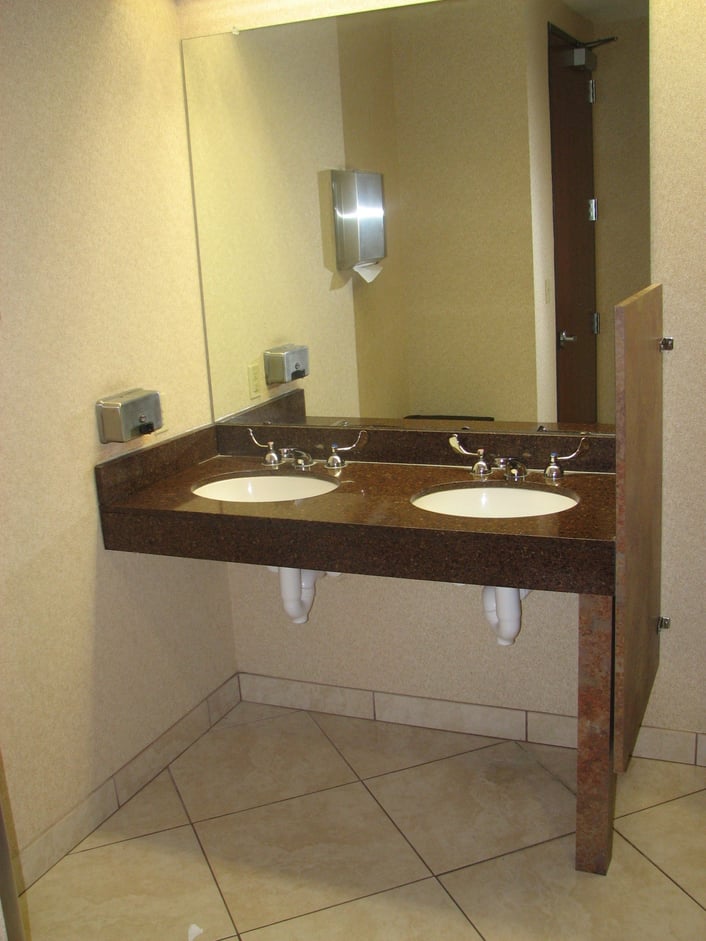
Traditionally bathroom vanities were constructed so the finished cabinet top was 30” AFF above finished floor.This meant that taller people had to bend over and stand away from the sink in order to use it.This puts added stress on the lower back and legs diminishing the comfort factor.Typically bathroom vanities are 21" deep and approximately 29" tall. The depth is not a problem but most folks would prefer a universal design height of 34". Sinks shouldn't be mounted higher than 34 inches from the floor to the top of the cabinet top for an under mount or drop in model. The sinks should not exceed six inches in depth and should be installed within three inches from the front of the overhanging cabinet top edge. The ADA vanity cabinet or even a simple wall hung sink should have a knee clearance below of 27 inches high and be at a minimum 30 inches wide by 11-25 inches deep. A 9" high clear kick area (by 6" deep) at the floor should be maintained for a full height cabinet and be approximately ten inches deep according to the cabinet depth. Remember twenty four inches is the maximum reach distance while sitting in a wheelchair. The choice of sink styles depends on the personal preference of the user. Be sure the lavatory controls are easily controlled with lever or paddle handles and are capable of being operated with one hand and not requiring tight grasping, pinching, or pinching of the wrist. Knobs, discs, or ball type handles can be hard to operate by anyone with soapy hands and more so by someone having an arthritic condition or other ailments. The closer the sink valves can be toward the front of the sink the better. This can be accomplished by following the curved outline of the sink.

Bathroom cabinets vary by style and usability. There are basically two styles of ADA bathroom vanities that comply with an unobstructed 27" tall roll under area below the sink. ADA sinks with a rear drain location provide for better plumbing drain hook ups. This modification has everything to do with both the water supply lines and the waste line connecting the sink. There must be provisions made to protect the user from being scalded when coming into contact with any one of the plumbing pipes serving the sink. These connecting pipes may become heated merely by the water passing through them creating the problem. The open type model should always receive both waste and supply insulating jackets applied directly to the pipes providing protection for the wheelchair user. The closed model concealing the pipes will be equipped with a removable face or face board covering the pipes. This pipe concealing panel must be installed at the correct wheelchair user clearance angle. This allows for the needed unobstructed legroom required for the user. The vanity can extend beyond the sink but the area containing the sink is required to have this roll under capability. This section of the vanity top must not be any taller than 34 inches above the finished floor with sufficient lower leg clearance. Clear unobstructed reach distances around the counter top area must be observed. Any motion controlled sensors integrated into the various dispensing devices and/or plumbing fixtures throughout the restroom present a true hands free benefit to all the restroom users. If these aren't in the budget then at least wrist handles used for controlling the faucet can be incorporated into the design of the vanity.
To assure a clear floor space the lavatory must be installed at 24" from any side wall measuring from the center line of the sink. The distance from one sink to another if using a double lavatory layout should be at least 30" center to center. In the case of wall hung freestanding sinks the minimum distance between them should be 4" between the sink edges. The clear floor space of 30 by 48 inches must be provided for accessing all bathroom fixtures and these areas can overlap one another. The adjoining and overlapping wheelchair turning space should be an unobstructed sixty inches in diameter. A wheelchair turning space could utilize a T-shaped space considering a sixty inch square having two 12"x24" areas removed from each corner of the square from the same side. This will be a 36" wide base with two 36" wide arms. T-shaped wheelchair turning spaces can include on one arm. In this case the clear width at the cabinet should be 36" to use the space as part of the T-turn.
Bathroom vanities with universal height cabinet tops and open knee spaces are taking over the marketplace. These new residential vanities do not need to look institutional even though they are wheelchair accessible. They can be designed like any other piece of fine furniture. Scalding must be guarded against by using either insulating pipe wrap or a removable panel for the plumbing.

Tags:
wheelchair accessible remodeling,
handicap home modifications,
ADA bathroom cabinets,
ADA compliance,
wheelchair accessible baths,
aging in place specialist,
certified aging in place specialist,
handicap remodeling contractors in Austin,
handicap remodeling contractors,
bathroom modifications for disabled,
disability home modifications,
ADA vanities,
residential remodeling contractor in Austin,
accessibility remodelers in Austin,
ADA remodeling Austin, Texas,
ADA bathroom Austin, Texas,
handicap bathrooms,
fine cabinetry in Austin, Texas,
universal design/build,
Austin Accessibility Design,
Austin ADA vanity,
home accessibility help in Austin,
bathroom remodel Austin,
universal design remodeling techniques,
universal design building contractor,
principles of universal design,
applying principles of universal design in Austin,
home remodeling for seniors Austin,
Austin Senior Home Remodeling,
remodeling for elders in Austin,
home remodeling for the elderly,
disability contractor in Austin,
special needs contractor in Austin,
disability and special needs contractor Austin,
senior home modifications in Austin,
home modifications for elderly in Austin,
bathrooms with disability access in Austin, Texas,
Austin disability contractors for special needs,
Austin handicap bathroom contractor,
handicap accessible remodeling,
barrier free remodeling,
handicap remodeling,
handicap accessible bathroom remodeling,
handicap accessible home renovations,
handicap accessible home modifications,
disability remodeling,
handicap accessible bathroom remodel,
Austin aging in place specialist,
handicap access bathroom remodel,
handicap bathroom remodel,
disability access contractor,
accessible home remodeling for disabilities,
home modifications for Austin veterans,
veterans home remodeling in Austin, Texas,
veterans home accessibility help in Austin, Texas,
ADA vanity in Austin,
ADA vanity height,
roll under vanity
Problems encountered while accessing your home when you are wheelchair bound generally begin before or at the front door. If you can reach the front porch approach without obstruction then you have a great start since the stairs leading onto the front porch can be another matter all together. A correctly designed ramp having a 1:12 slope can adequately solve this problem. The use of grab bars and any railings will be dictated by the ramp's design and the regulations and physical limitations involved. Once your safely upon the porch, your home's front door width can become an issue. Any entry door less than three feet in width will cause a problem in maintaining a required 32 inch clear entry way which starts the new accessible route within your home. Rolling over any vertical threshold height greater than 1/2" is also difficult to maneuver. Once inside the structure a new set of problems concerning your accessibility will be discovered.

A traditional home builder has never truly considered the special needs of the disabled or aging within any home design. Unfortunately the design emphasis is always put on aesthetics and takes for granted everyone's mobility. There certainly are no guarantees or clauses within any home's sales contract that will prevent our future personal life experiences from introducing us to at least a temporary disability. Accidents will always happen and you could find yourself having to utilize a wheelchair or walker to facilitate your independence for mobility. Limitations in our mobility or constantly changing needs experienced by both the disabled and the elderly have sprung a new dimension in construction known as ADA remodeling to accomplish increased accessibility. Our homes have always been exempt from any and all of the accessibility regulations that have been put in place since 1968 when our Viet Nam veterans were returning home. The new evolving concept known as Universal Design for home remodeling is catching on nation wide and has been for several years as a sign of the times. Universal design techniques used in building makes a home more accessible to all regardless of their mobility or adaptive abilities. An evolution of new products used for disability home modifications is making those homes more accessible and has finally come about in the remodeling industry. These new advances in accessible home remodeling in Austin not only keep the living environments safer but will not compromise the home's aesthetics.

An accessible bathroom for the user's convenience and safety becomes the first issue for anyone using a wheelchair or walker for either a short time while recovering or for the rest of their life. The disability access bathroom will be located within the home's accessible route. Any architectural barriers encountered while approaching the bathroom entrance will need to be removed. The minimum clear widths have to be observed. This will include the bathroom door itself. Twenty four to twenty eight inch wide doors are commonly used during the construction of American homes for accessing the bathroom. However, anything below three feet does not meet the 32 inch required clear width needed for clearance of a wheelchair. This work may involve framing alterations and moving light switches. The electrical changes should be done by a licensed electrician assuring your safety.
A completely serviceable special needs bathroom must contain at least one ADA vanity and the accessible route must be defined. The vanity must be one with a clear underneath scald protected area having an unobstructed roll under capability for wheelchairs. These new residential vanities do not need to look institutional. They can be designed like any other piece of fine furniture. A five foot turning radius allowing the wheelchair to maneuver into any approach must also be associated with the ADA vanity. A 36x48" clear approach area to the vanity must be observed and this can overlap the five foot turning radius. The area of travel will then be enhanced by an unobstructed clear accessible barrier free route dedicated to reaching the vanity.
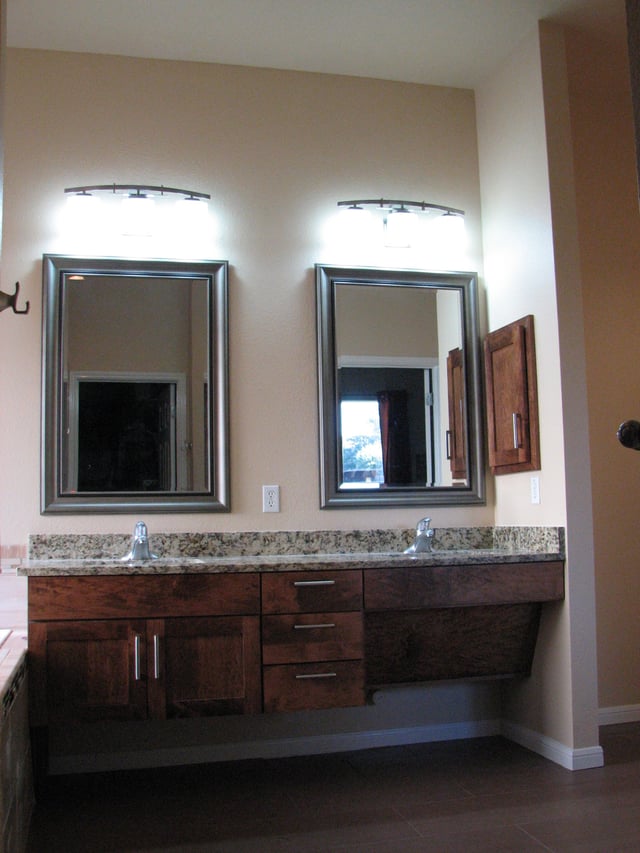
Bathroom cabinets in Austin vary by style and usability. There are basically two styles of ADA bathroom vanities that comply with an unobstructed 27" tall roll under area below the sink. ADA sinks with a rear drain location provide for better plumbing drain hook ups. This modification has everything to do with both the water supply lines and the waste line connecting the sink. There must be provisions made to protect the user from being scalded when coming into contact with any one of the plumbing pipes serving the sink. These connecting pipes may become heated merely by the water passing through them creating the problem. The open type model should always receive both waste and supply insulating jackets applied directly to the pipes providing protection for the wheelchair user. The closed model concealing the pipes will be equipped with a removable face or face board covering the pipes. This pipe concealing panel must be installed at the correct wheelchair user clearance angle. This allows for the needed unobstructed legroom required for the user. The vanity can extend beyond the sink but the area containing the sink is required to have this roll under capability. This section of the vanity top must not be any taller than 34 inches above the finished floor with sufficient lower leg clearance. Clear unobstructed reach distances around the counter top area must be observed. Any motion controlled sensors integrated into the various dispensing devices and/or plumbing fixtures throughout the restroom present a true hands free benefit to all the restroom users. If these aren't in the budget then at least wrist handles used for controlling the faucet can be incorporated into the design of the vanity. Furthermore, automatic flush valves should be used on all toilets and urinals that provide for hands free use.


Finding a contractor familiar with the guidelines of Elder construction and accessibility remodeling can be quite difficult. Be sure to check out the credentials of any potential bidders you contact. Be sure they understand that the alterations you are seeking are for wheel chair accessible home remodeling and modifications. Furthermore be sure this person knows and practices both the federal and most importantly your state's requirements before entering into any contract.
Aging in place home modifications are available through T-Square Company. We are a certified aging in place (CAPS) specialist. Each design/build situation will be customized to fit your personal needs. Call 512-444-0097 today to begin the accessible second chapter of your life while remaining safe and secure in your existing home. CAPS #1636580
Let's face it, accessible homes are needed by all of us at some time in our lives. This is true whether it's for ourselves, a family member, or a guest. The need is certainly not driven by age but is a result of life's experience. Any family living with disability among any of the generations within it's group can always benefit from additional accessibility. This will in turn increase safety and independence for all involved as they go through life.
Tags:
ADA accessible,
ADA bathroom cabinets accessible routes,
barrier free access,
aging in place home modifications,
ADA remodeling,
CAPS certified remodeling in Austin,
ADA bathroom cabinets,
ADA compliance,
aging in place remodels,
disability bathroom remodels,
handicap accessible bathrooms,
aging in place designs,
custom tub to shower conversions,
wheelchair accessible baths,
accessibility home remodeling in Austin,
CAPS professional in Austin,
accessible home remodeling,
Universal Design,,
Austin bath remodeling,
Austin bath remodel,,
Austin bathroom remodel,
disability home remodeling in Austin,
home modifications for independent living,
disability bathroom remodeling in Austin,
aging in place specialist,
aging in place services,
aging in place design,,
elder construction,
certified aging in place specialist,
handicap remodeling contractors in Austin,
Austin elder construction,
remodel bathroom for handicap Austin Texas,
handicap home modifications for disabled,
handicap accessibility,
handicap remodeling contractors,
bathroom modifications for disabled,
disability home modifications,
ADA vanities,
accessibility remodelers in Austin,
ADA remodeling Austin, Texas,
ADA bathroom Austin, Texas,
disability access bathrooms Austin,
disability remodeling in Austin,
Austin Handicap Remodeling,
Austin Accessibility Design,
Austin accessible home remodeling,
Austin ADA vanity,
certified aging in place consultant in Austin,
bathroom modifications for disabled in Austin, TX,
Austin disability contractors for special needs,
handicap accessible remodeling,
barrier free remodeling,
handicap accessible bathroom remodeling,
handicap accessible home modifications,
Austin aging in place specialist,
disability access contractor,
veterans home accessibility help in Austin, Texas,
accessible bathroom design specifications,
ADA vanity in Austin
















